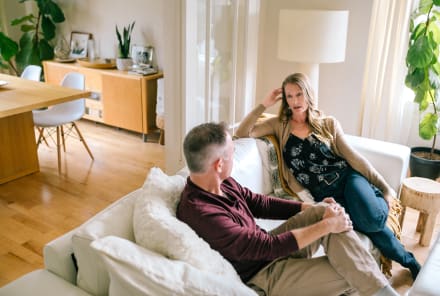Advertisement
I'm A Clinical Psychologist & We Need To Reframe How We Think About Attachment Styles


As a clinical psychologist, I hear a lot about attachment styles. One client even told me recently she felt she was "hard work because of her anxious attachment" and had to make up for it by letting other people get their way all the time.
This, along with the current attention on attachment styles, inspired me to write a piece on a disturbing phenomenon I've observed: when people define themselves solely by their attachment style and see themselves as less than because of it.
How does attachment style play out in adulthood?
Our attachment is the intimate bond that forms with our caregivers when we are infants. Depending on this attachment bond, as well as genetics, we develop a particular attachment style that helps us best survive and adapt to the environment we are born into—and this influences the way our relationships play out in the future.
The four attachment styles are as follows:
- Secure attachment: A secure attachment style refers to the ability to form secure, loving relationships with others. A person with a secure attachment style is able to trust others and be trusted, love and accept love, and become close to others with relative ease.
- Anxious attachment: An anxious attachment style is a type of insecure attachment style marked by a deep fear of abandonment. People with an anxious attachment style tend to be very insecure about their relationships, often worrying that their partner will leave them and thus are always hungry for validation.
- Avoidant attachment: An avoidant attachment style is a type of insecure attachment style marked by a fear of intimacy. People with an avoidant attachment style tend to have trouble getting close to others or trusting others in relationships because they ultimately don't believe their needs can be met in a relationship.
- Fearful-avoidant attachment (aka disorganized): A fearful-avoidant attachment style is a combination of both the anxious and avoidant attachment styles. People with fearful-avoidant attachment both desperately crave affection and want to avoid it at all costs.
As adults, our everyday experiences of relationships continue to mirror what happens in our attachment bond as children. We have needs that others can or cannot meet, and we may or may not be able to express them. We are interdependent on others for both material resources and for warmth and affection.
Having interdependent, healthy, and strong relationships helps us feel safe enough to express our needs and to create stable futures. However, in relationships where our needs are consistently not met—whether or not we express them—we may experience anxiety, avoidance, ambivalence, and other distressing feelings.
And it doesn't just affect our mental health. While great relationships are equally great for our physical health (i.e., happily married people have lower blood pressure than social singles), toxic and ambivalent relationships can actually be terrible for our heart health1.
As it is, the people we are in proximity to can affect our brain waves, heart rates, and blood pressure, driving home the importance of how we are shaped by the way we experience our relationships.
What we're getting wrong about attachment styles
The problem with this obsession with attachment styles is twofold.
First, people dismiss themselves and define themselves solely based on having a "bad" attachment style and therefore believe they must work harder and overextend in relationships. They incinerate energy and self-esteem by telling themselves they're a mess or difficult people, and the shame can be crippling.
This can also make you delicious prey for toxic dark personality types, who have a keenly attuned radar for people who work too hard in relationships and feel deficient about themselves—the perfect partners to exploit, abuse, and gaslight.
Second, people think that attachment style is a be-all and end-all. I see this in how some people similarly obsess over their personality types or neural wiring, using those things to justify their behavior as if there's no other way.
Instead, learning about our attachment styles is useful because we learn about how we automatically react to people. For example, someone anxiously attached may learn that they obsess over relationships way too early, and that may cause them to do or say things they regret later. Or, an avoidantly attached person may realize they tend to oscillate between disappearing and intense closeness.
As with all forms of self-awareness, this is about learning that we are not resigned to our patterns of behavior. Even if something feels very much like an autopilot setting, we learn to observe and break the cycle faster, so we feel more in control.
And in that process, rather than feeling intense shame and shutting down due to our actions, we learn to accept that this is currently our default wiring—and that we can do something about it instead of feeling helpless and creating more messes in our relationships.
For instance, acknowledging what's going on and then regulating our brains with three deep proper breaths can help us regain control. From there, we can learn to ask for our needs to be met, or even to script how to say that.
Reframing the way we think about attachment
Just because you have certain needs for closeness or space—or both at different times or with certain people—doesn't make you emotionally unhealthy, difficult, or less of a person.
Needing intimacy and space is not a marker of strength or weakness, it just is what it is. We simply have to ask for it in a healthy way. Because the truth is, human beings are interdependent creatures who cocreate our realities. Being doggedly overly independent or believing we have to always be very close to someone else (especially if this is based on some cultural idea and not based on what you actually need) are not healthy ways to live.
Because when we have our needs met, we co-regulate our heart rates and brain waves, and we feel safe. As I always say in corporate culture training, no amount of communication, relationship, or personality workshops are going to bear fruit if we do not feel psychologically safe.
Some other factors to think about here include:
- Your attachment style isn't just the reflection of your earliest relationships as an infant. Your attachment style could also be repeatedly shaped and reinforced by other relationships along the way, especially one that has caused you trauma. In this case, the brain does this thing called "repetition compulsion," where we are drawn into similar situations unconsciously that repeat the same storyline.
- Some people may dismiss the securely attached as boring, especially in the case of someone who's had a difficult childhood and/or traumatic experiences. The nervous system then mistakes chaos and danger for passion. Try to spend more time around secure people, reflecting what you enjoy with them, and to train your nervous system to like supposedly boring activities instead of simply seeking out stimulation all the time.
- What if your pattern of obsessing over relationships or needing space is telling you that you have needs that are unmet in your current relationship? For instance, when anxiously attached people are reassured about their worries and are given consistency and reliability, they become more securely attached.
Playing on the above, here are other questions to mull because our relationships are a house of mirrors:
- When I hang out with [insert person], I like myself a lot more or a lot less. Why? How does that feel in my body?
- Who do I not like being around? Why?
- Who am I trying to be a "hero" for when I persist in spending time with them? What are the stories I tell myself that keep me there (i.e., I need to be nice and not judge, because I don't like people to judge me; X has a difficult time/life, so I need to excuse their behavior)?
- Who do I call myself needy/difficult around? Why?
- Who do I always feel like keeping my distance from? Why?
- When I feel uncomfortable in my autopilot reactions to people based on my attachment style, what is my safe word to pause and regulate my nervous system?
- Based on the above, what kinds of people should I hang out more with?
And more importantly, you are more than just your attachment style because you are a complex ever-changing work of art. In order to learn how to define yourself more broadly, some questions to ask yourself include:
- How am I wired? Think in terms of neural wiring (especially if you are neurodiverse, like having ADHD or autism) and personality type (Big Five or Myers-Briggs).
- How do I take/spend energy? Think in terms of introversion/extroversion/ambiversion.
- What are my hobbies and my interests?
- What do I spend most of my days doing? This can include your work, your primary relationships, and your dreams.
- How was I raised? Think about your upbringing and the different defining chapters in your life.
- How have I raised myself? Think about the habits, disciplines, and interests you pursued along the way and the beliefs and value systems you both discarded and acquired consciously.
The takeaway
The truth is, our attachment styles can change with conscious awareness and effort, especially if we choose the relationships that are healthiest for us. When it comes to any kind of growth, I always advocate taking matters into your own hands because time does not always heal, and if we let our habits and mindsets stay passive, we calcify into a worse version of ourselves.
In contrast, we can always rig our brain pathways to our benefit—what neuroscience calls neuroplasticity. With enough practice, things will turn in your favor, and it starts with defining yourself beyond your attachment style.
Watch Next
Enjoy some of our favorite clips from classes
Enjoy some of our favorite clips from classes
What Is Meditation?
Mindfulness/Spirituality | Light Watkins
Box Breathing
Mindfulness/Spirituality | Gwen Dittmar
What Breathwork Can Address
Mindfulness/Spirituality | Gwen Dittmar
The 8 Limbs of Yoga - What is Asana?
Yoga | Caley Alyssa
Two Standing Postures to Open Up Tight Hips
Yoga | Caley Alyssa
How Plants Can Optimize Athletic Performance
Nutrition | Rich Roll
What to Eat Before a Workout
Nutrition | Rich Roll
How Ayurveda Helps Us Navigate Modern Life
Nutrition | Sahara Rose
Messages About Love & Relationships
Love & Relationships | Esther Perel
Love Languages
Love & Relationships | Esther Perel
What Is Meditation?
Box Breathing
What Breathwork Can Address
The 8 Limbs of Yoga - What is Asana?
Two Standing Postures to Open Up Tight Hips
How Plants Can Optimize Athletic Performance
What to Eat Before a Workout
How Ayurveda Helps Us Navigate Modern Life
Messages About Love & Relationships
Love Languages
Advertisement

Your Grandma's Go-To Supplement Is Once Again Popular (For A Good Reason)
Molly Knudsen, M.S., RDN

Your Grandma's Go-To Supplement Is Once Again Popular (For A Good Reason)
Molly Knudsen, M.S., RDN









